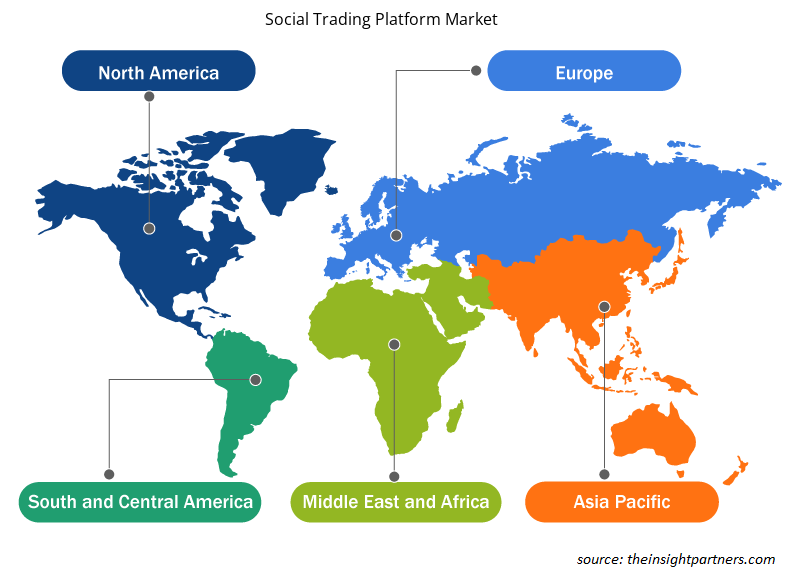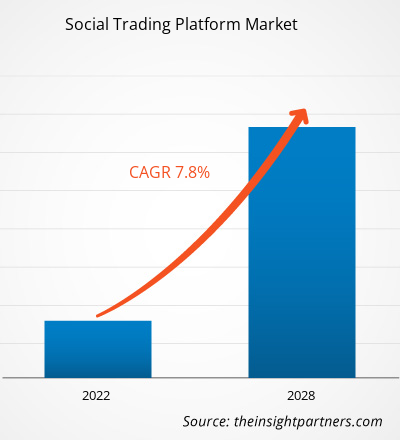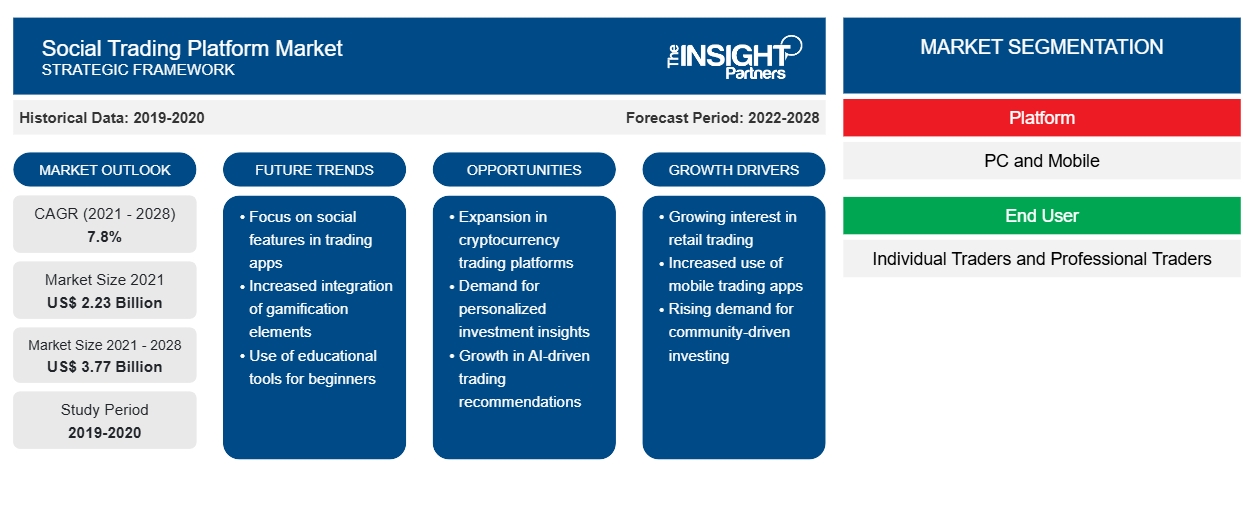Le marché des plateformes de trading social devrait passer de 2 229,56 millions de dollars américains en 2021 à 3 774,17 millions de dollars américains en 2028 ; il devrait augmenter à un TCAC de 7,8 % entre 2021 et 2028.
Les logiciels de plateforme de trading personnalisés augmentent efficacement les revenus des organisations et offrent une meilleure satisfaction client. Les traders adoptent largement une plateforme de trading personnalisée pour leur utilisation facile. La plateforme de trading personnalisée fournit aux clients des graphiques détaillés et faciles à lire, des statistiques en temps réel et des systèmes de reporting personnalisés. Par exemple, en mai 2021, ParagonEX (leader de la technologie financière) a lancé une plateforme de trading entièrement personnalisable, permettant à ses clients courtiers de décider de chaque détail de l'apparence et de la convivialité des plateformes. La personnalisation comprend chaque élément de la plateforme de trading, ce qui permet une personnalisation infinie par courtier ou utilisateur final. La nouvelle plateforme permet à chaque courtier d'avoir une apparence unique, affichant les éléments de son choix, créant ainsi une identité de marque distincte et répondant au profil et à la composition de ses utilisateurs finaux.
Le logiciel fournit également une analyse graphique avancée et détaillée en fonction des besoins des clients. Avec cette analyse graphique, la lecture et la compréhension d'une donnée donnée sont cruciales dans le secteur du trading. L'analyse graphique avancée offre aux utilisateurs des fonctionnalités flexibles et personnalisées qui permettent la préparation de graphiques en fonction des besoins des utilisateurs. Outre les avantages ci-dessus, une plateforme de trading personnalisée offre également plusieurs options pour lire et comprendre les tendances du secteur, prédire les fluctuations de prix, créer des graphiques personnalisés et personnalisés et gérer plusieurs comptes à partir d'une seule plateforme de trading social. Ainsi, en raison de tous ces avantages, contribuer à la croissance du marché des plateformes de trading social à l'échelle mondiale.
Personnalisez ce rapport en fonction de vos besoins
Vous bénéficierez d'une personnalisation gratuite de n'importe quel rapport, y compris de certaines parties de ce rapport, d'une analyse au niveau des pays, d'un pack de données Excel, ainsi que de superbes offres et réductions pour les start-ups et les universités.
-
Obtenez les principales tendances clés du marché de ce rapport.Cet échantillon GRATUIT comprendra une analyse de données, allant des tendances du marché aux estimations et prévisions.
Impact de la pandémie de COVID-19 sur le marché mondial des plateformes de trading social
Les plateformes de trading social ont été très présentes lors de la transformation numérique des institutions financières et des solutions et services bancaires. Selon l'article publié par Business Wire, les dépenses consacrées à la transformation numérique se sont élevées à 1,18 billion de dollars en 2019, soit une augmentation de 17,9 % par rapport à 2018, et le besoin de transformation numérique a soutenu la croissance du marché des plateformes de trading social.
En outre, en 2021 et 2022, l’assouplissement des mesures de confinement et la hausse des taux d’emploi ont eu un impact positif sur la croissance du marché des plateformes de trading social. L’augmentation de la tendance à l’investissement dans les crypto-monnaies a eu un impact positif sur la croissance du marché. Selon le Free Press Journal, le Bitcoin a explosé et a étonné le monde entier, passant d’environ 7 000 dollars américains en mars 2020 à plus de 54 000 dollars américains jusqu’en juin 2021.
Informations sur le marché des plateformes de trading social
Avantages croissants de l'intégration des chatbots aux plateformes de trading
Le secteur du trading en ligne connaît une croissance significative avec l'évolution des technologies avancées. En raison de la pandémie de COVID-19, le modèle de trading en ligne s'est renforcé en 2020. Selon l'article publié par Chatbots Life, il a également été observé que plus de 2,14 milliards de personnes dans le monde ont acheté des biens et des services en ligne en 2021, ce qui a entraîné une évolution rapide du secteur du trading en ligne à l'échelle mondiale. En raison de l'évolution rapide du secteur du trading en ligne, le défi pour les traders de suivre le rythme du changement pour rester à jour et traiter toutes les tâches augmente également parallèlement. Ainsi, l'intégration de chatbots basés sur l'IA est essentielle pour les organisations commerciales afin d'améliorer l'expérience client et la productivité.
Les chatbots jouent le rôle de courtiers personnels en aidant les traders dans leurs tâches et leurs opérations. Ils effectuent des recherches plus approfondies, obtiennent des informations sur les acheteurs, leurs besoins, leurs difficultés et leurs attentes, et fournissent une assistance 24h/24 et 7j/7 et répondent aux questions. Ils aident les utilisateurs à rester au courant des dernières tendances du marché qui peuvent améliorer les progrès de l'entreprise. De plus, l'intégration de robots financiers dans le système permet aux utilisateurs d'automatiser le processus de trading pour qu'il s'exécute en arrière-plan 24h/24 et 7j/7 sans interruption. La solution aide les utilisateurs à rester au courant des tendances du marché et à effectuer les bonnes transactions au bon moment.
De plus, l'intégration de chatbots dans les plateformes de trading en ligne des utilisateurs permet de traiter et d'analyser l'énorme étendue de données et d'effectuer des calculs mathématiques de manière efficace. De plus, les chatbots de trading sont un excellent outil d'apprentissage, en particulier pour les nouveaux traders. Par conséquent, les avantages multiples des chatbots dans le trading en ligne aident les organisations à rester compétitives et à améliorer les chances de réussite à long terme. Par conséquent, la demande de chatbots augmente sur les plateformes de trading social.
Informations sur le marché basées sur la plateforme
En fonction de la plateforme, le marché des plateformes de trading social est divisé en deux catégories : PC et mobile. En 2021, le segment mobile a dominé le marché des plateformes de trading social, représentant la plus grande part de marché.
Informations sur le marché basées sur l'utilisateur final
En fonction de l'utilisateur final, le marché des plateformes de trading social peut être divisé en deux catégories : les traders individuels et les traders professionnels. En 2021, le segment des traders individuels représentait la plus grande part de marché.
Aperçu régional du marché des plateformes de trading social
Les tendances régionales et les facteurs influençant le marché des plateformes de trading social tout au long de la période de prévision ont été expliqués en détail par les analystes d’Insight Partners. Cette section traite également des segments et de la géographie du marché des plateformes de trading social en Amérique du Nord, en Europe, en Asie-Pacifique, au Moyen-Orient et en Afrique, ainsi qu’en Amérique du Sud et en Amérique centrale.

- Obtenez les données régionales spécifiques au marché des plateformes de trading social
Portée du rapport sur le marché des plateformes de trading social
| Attribut de rapport | Détails |
|---|---|
| Taille du marché en 2021 | 2,23 milliards de dollars américains |
| Taille du marché d'ici 2028 | 3,77 milliards de dollars américains |
| Taux de croissance annuel moyen mondial (2021-2028) | 7,8% |
| Données historiques | 2019-2020 |
| Période de prévision | 2022-2028 |
| Segments couverts |
Par plateforme
|
| Régions et pays couverts |
Amérique du Nord
|
| Leaders du marché et profils d'entreprises clés |
|
Densité des acteurs du marché des plateformes de trading social : comprendre son impact sur la dynamique des entreprises
Le marché des plateformes de trading social connaît une croissance rapide, tirée par la demande croissante des utilisateurs finaux en raison de facteurs tels que l'évolution des préférences des consommateurs, les avancées technologiques et une plus grande sensibilisation aux avantages du produit. À mesure que la demande augmente, les entreprises élargissent leurs offres, innovent pour répondre aux besoins des consommateurs et capitalisent sur les tendances émergentes, ce qui alimente davantage la croissance du marché.
La densité des acteurs du marché fait référence à la répartition des entreprises ou des sociétés opérant sur un marché ou un secteur particulier. Elle indique le nombre de concurrents (acteurs du marché) présents sur un marché donné par rapport à sa taille ou à sa valeur marchande totale.
Les principales entreprises opérant sur le marché des plateformes de trading social sont :
- eToro
- Commerce A
- ZuluTrade
- Tornade
- MétaCitations
Avis de non-responsabilité : les sociétés répertoriées ci-dessus ne sont pas classées dans un ordre particulier.

- Obtenez un aperçu des principaux acteurs du marché des plateformes de trading social
Informations sur le marché basées sur les classes d'actifs
En fonction de la classe d'actifs, le marché des plateformes de trading social peut être segmenté en actions, matières premières, produits dérivés, crypto-monnaies et autres. En 2021, le segment des crypto-monnaies représentait la plus grande part du marché mondial des plateformes de trading social.
Les acteurs opérant sur le marché des plateformes de trading social ont adopté diverses stratégies, telles que les fusions et acquisitions, pour maintenir leurs positions sur le marché des plateformes de trading social. Quelques développements des principaux acteurs sont énumérés ci-dessous :
- En janvier 2022, eToro a élargi son offre d'investissement aux États-Unis pour inclure les actions et les ETF (fonds négociés en bourse) américains.
- En décembre 2021, eToro avait annoncé le lancement de son programme eToro Money pour les consommateurs britanniques. eToro Money s'intègre au compte d'investissement eToro d'un utilisateur, lui permettant de déposer et de retirer de l'argent instantanément et de gérer sa crypto et ses finances en un seul endroit.
Profils d'entreprise
- eToro
- Commerce A
- ZuluTrade
- Tornade
- MétaCitations
- PrimeXBT
- Marchés Pepperstone Limitée
- Moulin à tiques
- Octa Markets Incorporée
- Assetgro Fintech Pvt. Ltd (Stockgro)
- Holding public, Inc.
- Groupe Naga AG
- Boule de neige X
- Analyse historique (2 ans), année de base, prévision (7 ans) avec TCAC
- Analyse PEST et SWOT
- Taille du marché Valeur / Volume - Mondial, Régional, Pays
- Industrie et paysage concurrentiel
- Ensemble de données Excel
Rapports récents
Témoignages
Raison d'acheter
- Prise de décision éclairée
- Compréhension de la dynamique du marché
- Analyse concurrentielle
- Connaissances clients
- Prévisions de marché
- Atténuation des risques
- Planification stratégique
- Justification des investissements
- Identification des marchés émergents
- Amélioration des stratégies marketing
- Amélioration de l'efficacité opérationnelle
- Alignement sur les tendances réglementaires























 Obtenez un échantillon gratuit pour - Marché des plateformes de trading social
Obtenez un échantillon gratuit pour - Marché des plateformes de trading social